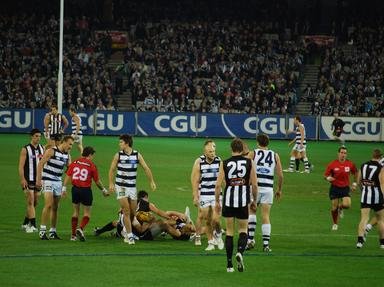Quiz Answer Key and Fun Facts
1. It's the last quarter of the 1971 Grand Final between Hawthorn and St Kilda. Hawthorn's Peter Hudson has 150 goals for the season, three goals in this match, equalling Bob Pratt's record. He has three chances to break the record outright, but somehow didn't manage it. Which of these did *not* happen in the tense last quarter to Hudson?
2. The 1970 Grand Final between Carlton and Collingwood is certainly one of the most famous Grand Finals, involving the "mark of the century" and Carlton's comeback after being down by 44 points at half-time. However, despite Collingwood being the victim in this match, they had done something similar to what Carlton did in this game earlier in the season by coming back after being down by a seemingly unassailable margin against St Kilda. What margin were Collingwood down by at half-time in this Round 10 match?
3. I played two games for Hawthorn, both of them in 1975, both against North Melbourne. I kicked a third of the team's goals in the semi-final, my first game, but in the Grand Final, my second and final game, I failed to record a stat, was taken off, and never played again. Who am I?
4. In Round 6, 1977 at Princes Park, Hawthorn mauled St Kilda by 88 points, having an absolutely astonishing 66 scoring shots to St Kilda's 23. What was Hawthorn's final score?
5. In the classic drawn Grand Final of 1977 that finished 76-76 between North Melbourne and Collingwood, both teams were very inaccurate. Collingwood finished with 10 goals 16 behinds, and North finished with 9.22. North's Arnold Briedis was the worst offender, kicking 0 goals and how many behinds?
6. All four of these players who played in the 70s were born overseas. Three of them were born in Germany. Which one of these was *not* born in Germany?
7. North Melbourne's superstar Malcolm Blight was known for many things, including possessing a lethal right-foot kick. This came in especially handy in Round 10 of 1976 against Carlton at Princes Park. After trailing by over three goals in the last quarter, Blight kicked three goals in this quarter, including a monster 85 metre torpedo after the siren that sailed through post-high. How many points did this enable North to win by?
8. The 1969 season began a sequence of Grand Finals, through to the 1982 Grand Final, that saw only six teams participate - North Melbourne, Collingwood, Richmond, Carlton, St Kilda and Hawthorn. Who was in the most Grand Finals in that time and how many were they in? (including replays there were 15 grand finals played)
9. These days if someone kicks 100 goals in a season, they're guaranteed to finish as the league's leading goalkicker. That's not how it was back in 1972, with Essendon's bespectacled Geoff Blethyn coming runner-up to Collingwood's Peter McKenna, who had 130 goals. How many goals did Blethyn have that season, including finals?
10. In 1973, the centre diamond was introduced to reduce congestion in the centre of the ground, allowing only four players from each team inside it at centre bounces. How many years did the centre diamond last, before it was changed to the centre square?
Source: Author
zoomba23
This quiz was reviewed by FunTrivia editor
gtho4 before going online.
Any errors found in FunTrivia content are routinely corrected through our feedback system.
